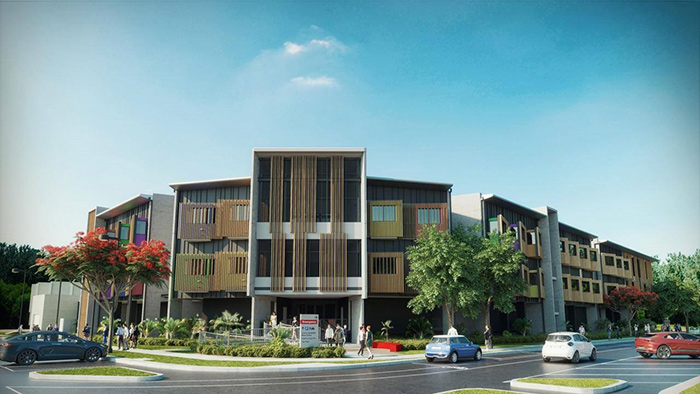For architects and designers, the construction and renovation of hospitals, health centres, doctors’ surgeries and nursing homes are always challenging. On the one hand the objective is to increase the comfort level of patients and staff through great design. On the other hand, functional requirements such as sturdiness, hygiene, wellness and durability must be satisfied.
These challenges call for innovative products.
Key issues
Designing for the health sector requires an awareness of several key issues, including:
- Acoustics: Acoustic comfort plays a crucial part in creating comfortable healthcare environments. A space that is acoustically comfortable facilitates patients’ recovery through maintaining privacy and reducing the stress of a noisy environment.
- Impact resistance: Wall surfaces must be able to withstand the wear and tear expected in these facilities due to the high volume of staff, patients and visitors using these areas. Add to that hospital beds, trolleys and equipment that are constantly being moved around, knocking against wall surfaces and causing damage.
- Shelf loading: Hospital walls must be able to support a wide range of fittings and fixtures, from the artwork in the waiting room, accessories in the bathroom to heavy equipment in speciality rooms.
- Aesthetics: There is an increasing trend toward designing hospitals with patient‐centred features such as improved natural light, visitor-friendly facilities, well‐decorated rooms and hotel‐like amenities, even leading to the term ‘healing architecture’.
- Hygiene and infection control: Robust internal surfaces and finishes are essential to maintaining hygiene and controlling infection, with areas such as operating rooms requiring particular attention. Walls must withstand rigorous cleaning and sanitising, and be resistant to damage.
- Fire protection: Resistance and protection from fire is a critical factor in plasterboard throughout hospitals, particularly in lift shafts.
- Water resistance: In wet areas including toilets, showers, laundries and kitchens, low maintenance water-resistant solutions help reduce moisture damage and mould growth.
- Mould: Mould spores can have a detrimental effect on the health of patients and hospital workers. Unfortunately mould growth is not always immediately visible. It may grow on the back of wall linings and go unnoticed for a long time, so it is important to choose materials that are inherently mould-resistant.
Trurock and Trurock HD
Trurock and Trurock HD offer a 5-in-1 plasterboard option that is perfect for the healthcare industry. Both products offer sound insulation properties together with impact, water, mould and fire resistance.
Because of their superb impact resistance, these boards can resist the effects of wear and tear expected in public health settings. Both boards are made with a high-density gypsum core embedded with a continuous fibreglass reinforcement and recycled heavy duty liner paper.
The only difference between the two is the continuous glass fibre mesh embedded in the gypsum core of Trurock HD. This mesh gives Trurock HD the edge when it comes to impact performance.
During large hard body impact testing, Trurock HD was exposed to impact with the equivalent energy of a cricket ball travelling at 60km/h. Standard plasterboard was penetrated at the first impact while Trurock resisted until the 4th impact. Trurock HD could withstand penetration until the 10th impact.
The increased impact resistance is of special value in corridors and hospital wards where high traffic is to be expected. By resisting the knocks of daily activity in this area, the longevity of the walls is improved and maintenance is reduced.
Further benefits
One of the key benefits of a 5-in-1 plasterboard is that it simplifies ordering, delivery and installation on-site. Dealing with one supplier has the benefit of a streamlined process as does dealing with just one person in the event of any change.
Trurock and Trurock HD make it easier for customers chasing sustainability goals. Both boards are available under Siniat's Opt2Act carbon neutral program. Opt2Act offers a simple and cost-effective way to reduce the upfront carbon emissions of a build by up to 7%.
Trurock and Trurock HD are also certified by Global GreenTag to GreenRate Level A.
Cairns Mental Health Unit

Siniat is currently supplying Trurock to the new $70 million, 53-bed Mental Health Unit at the Cairns Hospital. The three-storey building forms part of a bigger expansion of the Cairns Hospital and expected completion is at the end of 2024.
Siniat is supplying 20,000m² of Trurock to the project.
Main image: Trurock HD

